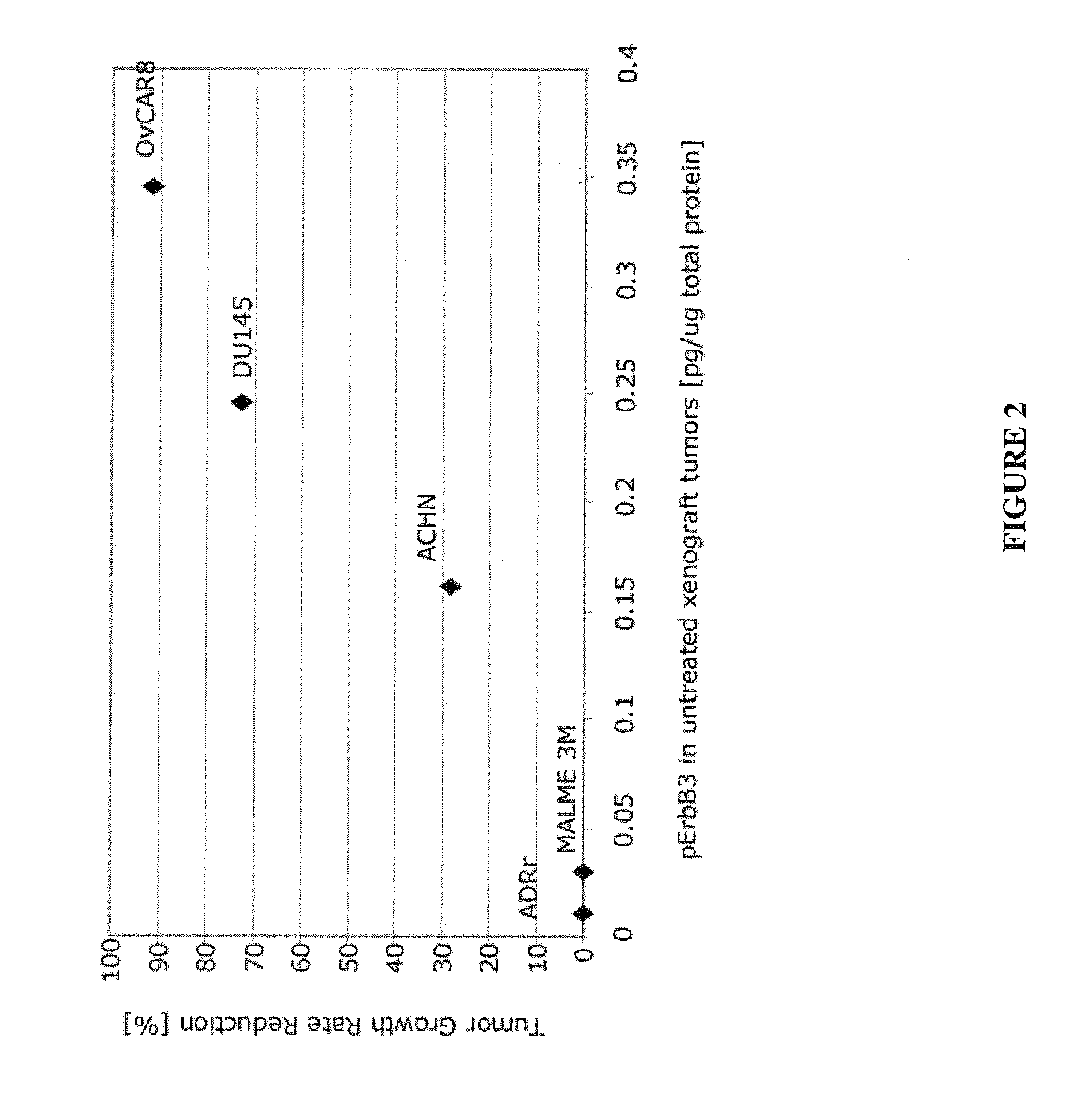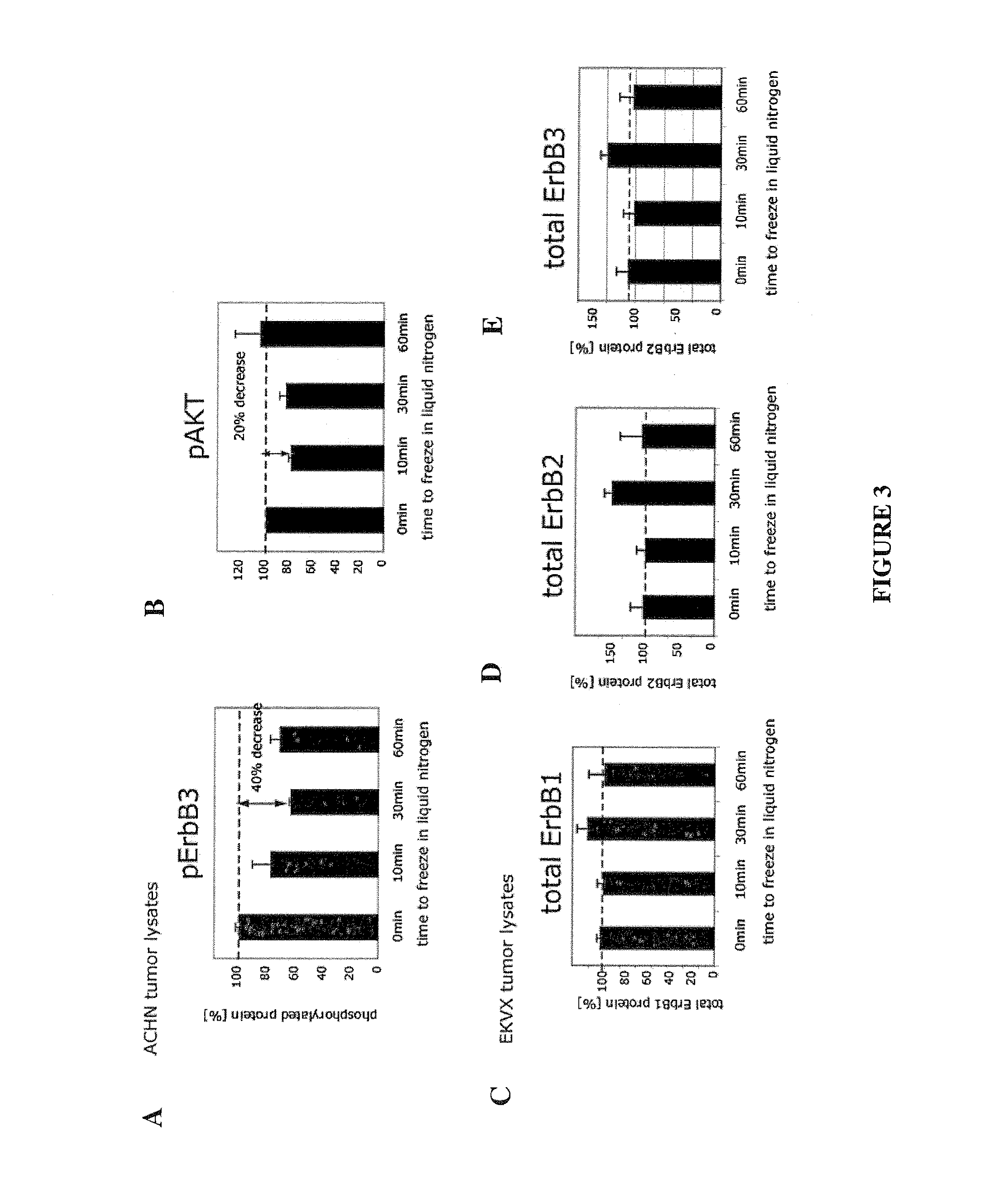Methods, systems and products for predicting response of tumor cells to a therapeutic agent and treating a patient according to the predicted response
a technology of tumor cells and therapeutic agents, applied in the field of methods, can solve the problems of not being able to identify such markers for all therapeutic agents, tumors that cannot guarantee the responsiveness of cetuximab, and the inability to predict the response of tumor cells to a therapeutic agent,
- Summary
- Abstract
- Description
- Claims
- Application Information
AI Technical Summary
Problems solved by technology
Method used
Image
Examples
example 1
Xenograft Efficacy Studies with Ab #6: Training Data Set
[0230]In this example, four xenograft tumor models were used to identify tumor cell lines that responded to treatment with the anti-ErbB3 antibody Ab #6. The four xenograft tumor models studied represent different indications: MALME3M (melanoma cancer line; ATCC No. HTB-64), ADRr (ovarian cancer cell line; NCI-60, cosmic sample ID No. 905987), ACHN (renal cancer cell line; ATCC No. CRL-1611) and DU145 (prostate cancer cell line; ATCC No. HTB-81). As described in further detail below, the MALME3M and ADRr xenografts did not show a response to treatment with Ab #6, whereas the ACHN and DU145 xenografts did show a response to Ab #6 treatment.
[0231]In the xenograft tumor models, mice (nu / nu mice: 3-4 week old female mice, T-cell deficient; outbred; Albino background; from Charles River Labs, Wilmington, Mass.) are implanted in the right flank with 3.5×106−3×108 cells / mouse (depending on cell line) in 200 μl via subcutaneous injecti...
example 2
pErbB3 Levels in Tumor Cell Line Lysates Correlate with Ab #6 Responsiveness in Xenografts
[0235]In this example, the concentration of phosphorylated ErbB3 (pErbB3) was measured in vivo in each of the four tumor cell lines studied in Example 1, MALME3M, ADRr, DU145 and ACHN, in a short term pharmacodynamic (PD) study. The OvCAR8 xenograft also was included in this experiment (this xenograft is shown to be responsive to Ab #6 treatment in Example 5 described below).
[0236]MALME3M, ADRr, DU145, OvCAR 8 and ACHN cells are grown in culture and harvested for implantation (15×15 cm plates, ˜80% confluency, total # of cells=2−4×108) and kept on ice until implantation. Cells (approximately 2×107 cells / mouse) are implanted into 20 mice (via subcutaneous injection, 200 μl cells / injection / mouse) into the right flank and then the mice are allowed to recover while being monitored for initial tumor growth. Tumors are measured (L×W) by digital caliper measurement. Once the mice reached a tumor volum...
example 3
pErbB3 and pAKT Levels Decrease as a Function of Time to Freeze
[0243]In this example, the stability of pErbB3 and pAKT was assessed, as well as the expression levels of ErbB I, ErbB2 and ErbB3, in tumor lysates as a function of time after resurrection from freezing the tumor.
[0244]Untreated ACHN and EKVX xenograft mice are euthanized by CO2 asphyxiation and tumors are dissected and cut into 4 pieces and put into liquid nitrogen at different time points: 0 min, 10 min, 30 min, and 60 min. Then, pErbB3 and pAKT levels, as well as ErbB1-3 levels, are measured in each of the samples after thawing. The results obtained using the methods described above or minor variations thereof are summarized in the bar graphs shown in FIGS. 3A-3E, with FIGS. 3A and 3B showing the levels of pErbB3 and pAKT, respectively, in the ACHN lysates and FIGS. 3C, 3D and 3E showing the levels of ErbB1, ErbB2 and ErbB3, respectively, in the EKVX lysates.
[0245]As shown in FIGS. 3A and 3B, in the 10 minute samples,...
PUM
| Property | Measurement | Unit |
|---|---|---|
| volume | aaaaa | aaaaa |
| time | aaaaa | aaaaa |
| concentration | aaaaa | aaaaa |
Abstract
Description
Claims
Application Information
 Login to View More
Login to View More - R&D
- Intellectual Property
- Life Sciences
- Materials
- Tech Scout
- Unparalleled Data Quality
- Higher Quality Content
- 60% Fewer Hallucinations
Browse by: Latest US Patents, China's latest patents, Technical Efficacy Thesaurus, Application Domain, Technology Topic, Popular Technical Reports.
© 2025 PatSnap. All rights reserved.Legal|Privacy policy|Modern Slavery Act Transparency Statement|Sitemap|About US| Contact US: help@patsnap.com



